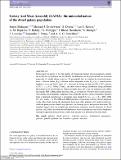Galaxy And Mass Assembly (GAMA) : the unimodal nature of the dwarf galaxy population
Abstract
In this paper we aim to (i) test the number of statistically distinct classes required to classify the local galaxy population and (ii) identify the differences in the physical and star formation properties of visually distinct galaxies. To accomplish this, we analyse the structural parameters – effective radius (Reff), effective surface brightness within Reff (⟨μ⟩e), central surface brightness (μ0) and Sérsic index (n) – obtained by fitting the light profile of 432 galaxies (0.002 < z ≤ 0.02; VikingZ band), and their spectral energy distribution using multiband photometry in 18 broad-bands to obtain the stellar mass (M*), the star formation rate (SFR), the specific SFR (sSFR) and the dust mass (Mdust), respectively. We show that visually distinct, star-forming dwarf galaxies (irregulars, blue spheroids and low-surface-brightness galaxies) form a unimodal population in a parameter space mapped by ⟨μ⟩e, μ0, n, Reff, SFR, sSFR, M*, Mdust and (g − i). The SFR and sSFR distribution of passively evolving (dwarf) ellipticals on the other hand, statistically distinguish them from other galaxies with similar luminosity, while the giant galaxies clearly segregate into star-forming spirals and passive lenticulars. We therefore suggest that the morphology classification scheme(s) used in literature for dwarf galaxies only reflect the observational differences based on luminosity and surface brightness among the apparent distinct classes, rather than any physical differences between them.
Citation
Mahajan , S , Drinkwater , M J , Driver , S , Kelvin , L S , Hopkins , A M , Baldry , I , Phillipps , S , Bland-Hawthorn , J , Brough , S , Loveday , J , Penny , S J & Robotham , A S G 2015 , ' Galaxy And Mass Assembly (GAMA) : the unimodal nature of the dwarf galaxy population ' , Monthly Notices of the Royal Astronomical Society , vol. 446 , no. 3 , pp. 2967-2984 . https://doi.org/10.1093/mnras/stu2009
Publication
Monthly Notices of the Royal Astronomical Society
Status
Peer reviewed
ISSN
0035-8711Type
Journal article
Collections
Items in the St Andrews Research Repository are protected by copyright, with all rights reserved, unless otherwise indicated.
Related items
Showing items related by title, author, creator and subject.
-
SDSS-IV MaNGA: How the stellar populations of passive central galaxies depend on stellar and halo mass
Oyarzún, Grecco A.; Bundy, Kevin; Westfall, Kyle B.; Tinker, Jeremy L.; Belfiore, Francesco; Argudo-Fernández, Maria; Zheng, Zheng; Conroy, Charlie; Masters, Karen L.; Wake, David; Law, David R.; McDermid, Richard M.; Aragón-Salamanca, Alfonso; Parikh, Taniya; Yan, Renbin; Bershady, Matthew; Sánchez, Sebastián F.; Andrews, Brett H.; Fernández-Trincado, José G.; Lane, Richard R.; Bizyaev, D.; Boardman, Nicholas Fraser; Lacerna, Ivan; Brownstein, J. R.; Drory, Niv; Zhang, Kai (2022-07-06) - Journal articleWe analyze spatially resolved and co-added SDSS-IV MaNGA spectra with signal-to-noise ratio ∼100 from 2200 passive central galaxies (z ∼ 0.05) to understand how central galaxy assembly depends on stellar mass (M*) and halo ... -
Secular-and merger-built bulges in barred galaxies
Mendez Abreu, Jairo; Debattista, V. P.; Corsini, E. M.; Aguerri, J. A. L. (2014-12) - Journal articleContext. Historically, galaxy bulges were thought to be single-component objects at the center of galaxies. However, this picture is now questioned since different bulge types with different formation paths, namely classical ... -
Galaxy And Mass Assembly (GAMA) : galaxy close pairs, mergers and the future fate of stellar mass
Robotham, A. S. G.; Driver, S. P.; Davies, L. J. M.; Hopkins, A. M.; Baldry, I. K.; Agius, N. K.; Bauer, A. E.; Bland-Hawthorn, J.; Brough, S.; Brown, M. J. I.; Cluver, M.; De Propris, R.; Drinkwater, M. J.; Holwerda, B. W.; Kelvin, L. S.; Lara-Lopez, M. A.; Liske, J.; Lopez-Sanchez, A. R.; Loveday, J.; Mahajan, S.; McNaught-Roberts, T.; Moffett, A.; Norberg, P.; Obreschkow, D.; Owers, M. S.; Penny, S. J.; Pimbblet, K.; Prescott, M.; Taylor, E. N.; van Kampen, E.; Wilkins, S. M. (2014-11-11) - Journal articleWe use a highly complete subset of the Galaxy And Mass Assembly II (GAMA-II) redshift sample to fully describe the stellar mass dependence of close pairs and mergers between 10(8) and 10(12)M(circle dot). Using the analytic ...

